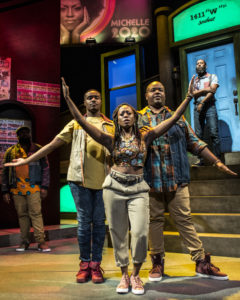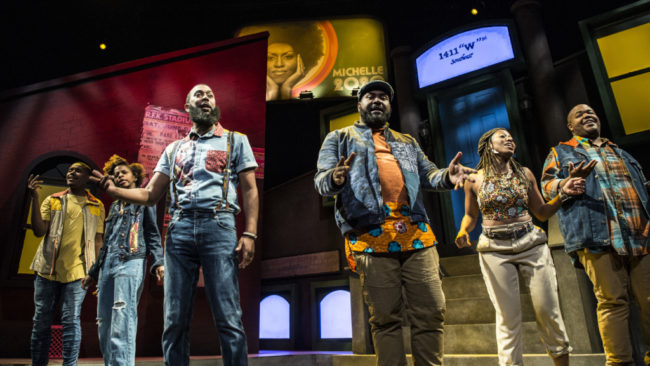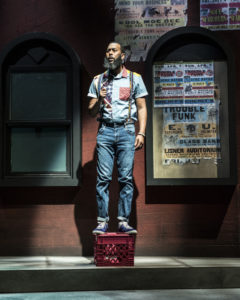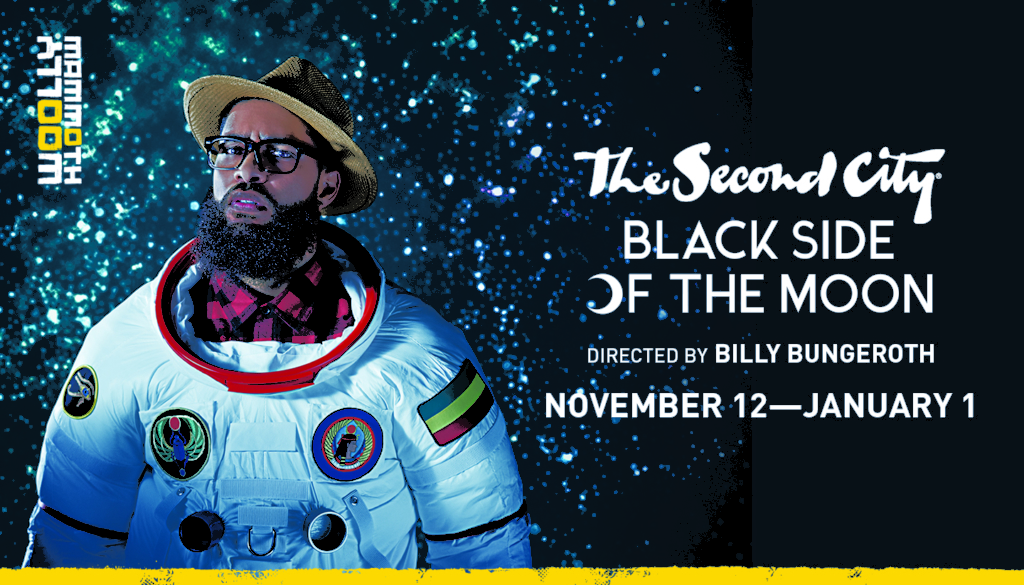Returning from the windy city as if often the tradition at this festive time of year, The Second City is back in the nation’s capital with Black Side of the Moon and they’re ready to put hot sauce in our pants with all of their comic antics and feel-good messages in this seemingly unending darkened political time. With roughly one third of the show being rewritten just days before opening due to the surprising political upset in the Presidential Election, The Second City is able to bring together messages of faith, hope, and love through humor, hilarity, and hijinks on the stage when America needs it the most. Directed by Billy Bungeroth, this hybrid of sketch comedy and stand-up comedian presentation will top any episode of Saturday Night Live and is potently charged with a powerful message for this politically unsettled times.

Colin K. Bills shows the audience an urban street scene with an enormous un-ignorable billboard— ‘Michelle 2020’ serving as the overriding beacon of hope throughout the production. Bills’ approach to the lighting is subtle but clever. Whenever a menacing Trump-type joke or sketch arises the marquee square above the brownstone stoop is highlighted in orange. This colorful infusion is used throughout the performance in a myriad of different hues— red for other negative or frightening moments, blue for liberal and positive scenes, etc. Bills’ work is augmented by Sound Designer Julie Nichols who gives us a great deal of music and rhythm when and where it’s appropriate to keep the show moving along.
Director Billy Bungeroth has a firm handle on the show’s pacing, as well as the inherently interactive nature of certain segments of the production. Shorter sketches move quickly and the way Bungeroth executes transitions from one vignette or bout of standup to the next showcases a fluidity that is critical to keeping the audience’s spirits uplifted. That is not to say that the entire evening is nothing but belly-laughs and deep chuckles. There are moments of emotional gravity and intense severity that crash over the performance and it is Bungeroth’s ability to draw a line of balance between these serious instances and the comically charged ones that keeps the play from swaying too far in either the irreverent or grave direction.
Peppered throughout the performance are three different stand-up comedian routines— Dave Helem, Sonia Denis, and Felonious Munk— and these are woven into the sketch-based nature of the show. Helem arrives first and although his approach to standup is somewhat more circuitous and at first seems to leave open-ended tangents to his ‘anecjokes’ by the time he comes to his ultimate conclusion everything is tied together with a feel-good laugh. Denis, who is a burst of frenetic energy and never stops moving as she delivers her stand-up routine, takes the ‘personal-in-a-hurry’ approach to delivering jokes and has a strong sense of urgent pacing in her delivery. Munk, whose stand-up snowballs into the show’s conclusion, is a praiseworthy experience all his own. If his stand-up was the only thing being presented over the evening, the cost of admission would still be well worth it.

The ensemble performers play well off one another, falling in and out of the character sketches that tackle issues of race, gender, and political natures. The opening statement includes the line, “we laugh so we don’t cry,” and serves as an invitation to the audience to laugh along with them, though some of the humor may feel uncomfortable. Theatre, especially where Woolly Mammoth is concerned, is designed to spark a conversation and often times that conversation pushes individuals— both on the stage and in the house— out of their comfort zone and the presentation delivered in Black Side of the Moon is no exception. Audience participation is not required though when the sextet do draw forth members of the audience onto the stage it upends the prepared dynamic and takes the show into uncharted territory which they navigate sublimely.
Each of the performers has their moment to shine, whether it’s Dewayne Perkins and his “Broadway DJ” sketch— which speaks volumes to the level of theatrical education and awareness among theatergoers in the audience (and imaginably more so now that #nameapencemusical has taken over the internet)— or Angela Alise’s rap-battle throw down about refusing to accept white-washed history, everyone has a moment for which they become remembered in the production. Dave Helem’s claim to fame, in addition to his stand-up routine, becomes his Bill Cosby impersonation, while for Torian Miller it’s his sketch character that appears in a recurring vignette about high school reunions.

Serving as the group leader, as he both introduces the show and closes the show, Felonious Munk is hilarious and worthy of the utmost respect when it comes to delivering his more serious points. Munk’s impersonation of Obama is an absolutely scream; he has perfected the President’s speech patterns and patois right down to the minutia of inflection. The message he delivers at the end of his stand-up routine about the black experience is strikingly profound, showcasing his ability to find balance in humor and truth and to express himself using both.
A remarkable balm for the heart and soul at this time of year, regardless of race or gender, the laughter coming out of Black Side of the Moon is the prescription the nation needs to start feeling better again, to start seeing the light at the end of the tunnel as something other than the oncoming train.
Running Time: 1 hour 50 minutes with one intermission
The Second City’s Black Side of the Moon plays through January 1, 2017 at Woolly Mammoth Theatre Company— 641 D Street NW in the Penn Quarter District of Washington DC. For tickets call the box office at (202) 393-3939 or purchase them online.

